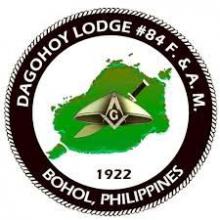
Dagohoy Lodge No. 84
The Name
This lodge was named after a famous rebel chieftain, Francisco Dagohoy, who led a revolt against the Spaniards in Bohol that lasted 85 years, the longest in the history of the Philippines. The historian of Dagohoy Lodge informs us that Dagohoy was actually named Francisco Sendrijas. When he rebelled against the Spaniards he was a Cabeza de Barangay in the town of Inabanga, Bohol which is why he already had a family name.
The historian adds that the word Dagohoy is a concatenation of the Sugboanan Bisayan words "Dalton Sa Huyuhoy”. Dagon is talisman in English while Huyuhoy means breeze. As an Agglutinative language, it is usual in Sugboanon Bisayan to concentrate long words. Thus, Dagon Sa Huyuhoy was shortened to Dagohoy, which still means talisman of the breeze. Dagohoy was the nom de guerre(war name) used by Francisco Sendrijas.
The Lodge
In September 1922, fourteen (14) Master Masons, led by Alfonso Lecaros, a Veterinary Doctor, and Eulalio Tanedo, a P.C. Officer, disseminating the light of Masonry in the Visayas signed a petition the Grand Lodge for an authority to organize a Masonic lodge in Tagbilaran, Bohol with Maktan Lodge No. 30, as the sponsoring lodge. The fourteen (14) petitioners were: Alfonso Lecaros, Onesimo Urbistondo, Joaquin Alix, Severo Fuentebella, Segundo Cinco,Timoteo Yu Tiong, Felix. Go Chan, Calixto Yu E. Huat, Adolfo Aldaba, Vicente Kierulf, Eulalio Tanedo, Federico M. Jardiniano, Buenaventura N. Adriano, and Augusto Piccio.
Not one of the petitioners was from Tagbilaran. Most were from Cebu and for them the establishment of the lodge called for great personal sacrifices because they had to travel five (5) hours by boat from Cebu to Tagbilaran just to attend meetings. But their sacrifices would be rewarded with success. In time permanent residents of Tagbilaran dominated the roster of the lodge.
Through the efforts of Severo Fuentebella, a dispensation was issued on October 20, 1922 by Grand Master Quintin Paredes. The dispensation named Alfonso Lecaros, Eulalio Tanedo, and Adolfo Aldaba as Worshipful Master, Senior Warden and Junior Warden, respectively. The first meeting of the lodge was held on November 23, 1922.
On January 24, 1923, the Grand Lodge granted a charter to Dagohoy Lodge No. 84. Five months later, on June 23, 1923, the lodge was formally constituted and its officers installed by Grand Master Frederic H. Stevens and other dignitaries of the Grand lodge. The ceremonies, which were attended by prominent citizens of Bohol, were held in the inner court of the Bohol High School building (now: Dr. Cecilio Putong National Highschool.)
Before the end of 1923, the Dagohoy Lodge No. 84 acquired the lot where the present Masonic Temple now stands. Construction materials were obtained from the forests of Anda and Sierra-Bullones, Bohol. The actual construction started in April 1928 and the Temple was finished by the end of the year. Before that, from 1923 to 1928, the lodge conducted its meetings in rented houses in Tagbilaran. The present form of Freemasonry in Bohol was planted on hardy ground. In turn it produced hardy Masons like Frank Lombardo, Bernardo Palma, Arturo Fortich, Pio C. Castro, Catalino Castillo, etc. These men were undaunted in their love of Freemasonry even in the face of relentless attacks from the dominant Church.
The most important cog in the early life of Dagohoy Lodge No. 84 was WB Bernardo Palma. He was a permanent resident of Tagbilaran, Bohol and an employee of the District Engineering Office. As the Lodge Secretary for a long time, he provided the needed stability and continuity, especially since most of the early members were government functionaries subject to reassignment anytime.
On January 11, 1931, Bro. Arnold Bartlett died. He was the Superintendent of Schools in Bohol. Although he was a Roman Catholic, he was refused burial in the Roman Catholic Cemetery of Tagbilaran, Bohol. The experience prompted the brethren to establish their own Masonic Cemetery. On March 9, 1931, a committee composed of Anacleto Sevilla, Felix Maceda, and Emilio Buenaventura, Jr., was organized to look for a land suitable for use as a cemetery. On November 14, 1931, a 2,750 sqm. lot located at Dampas, Tagbilaran was acquired, then on June 1932, the adjoining lot was also purchased to increase the land area of the cemetery. The Masonic Cemetery was formally dedicated on November 6, 1937 during the visit of Grand Master Joseph H. Alley.
October 6, 1935, was red-letter day by the lodge. The members from near and far, including their families, gathered at the residence of Bro. J. D. Jimenez in Tagbilaran to listen to an important radio broadcast, the first of the Masonic radio shows broadcast over Station KZRM, Manila. The radio in those days was a novelty and not everyone had one. Among those who had come from distant places were Frank Lombardo and his family, from Ubay, 125 l kilometers away; the family of Alejandro Caday, from Jagna, 65 kms; Macario Sañiel, Gregorio Loquellano, and Nicanor Logrono, from Carmen, 61 kms; Casimiro B. de Sagun and German Yap, from Bilar, 42 kms; Claudio Butalid, Leoncio Marapao and Eduardo D. Paloc from Calape, 42 km.
During World War II, the Filipinos incarcerated in Camp O'Donnell, numbering, some 50,000, were under the over-all command of Major General Guillermo Francisco who was a member of Dagohoy Lodge No. 84. Another Mason from Dagohoy Lodge No. 84, Major Deogracias U. Tenazas, headed sub-group of the prisoners of war.
The present membership of Dagohoy Lodge may not be numerous but it includes prominent citizens like a former Provincial Governor, former Vice Governor, RTC Judges, DECS Director, Prosecutors, Businessmen, Professionals, Professors, Military Officers, Sailors, and other dedicated men in Bohol.
Today the Masonic family in Bohol includes an Eastern Star Chapter, a DeMolay Chapter, and a Rainbow for Girl Chapter.
Location: Tagbilaran City
 The Most Worshipful Grand Lodge of Free and Accepted Masons of the Philippines
The Most Worshipful Grand Lodge of Free and Accepted Masons of the Philippines